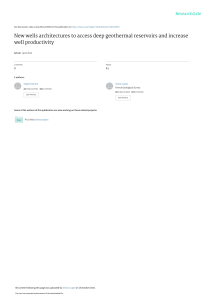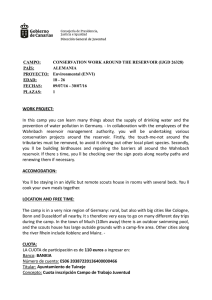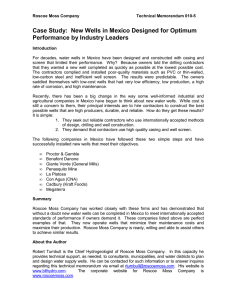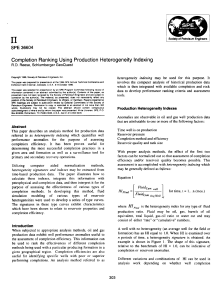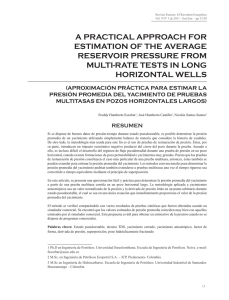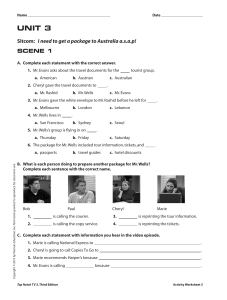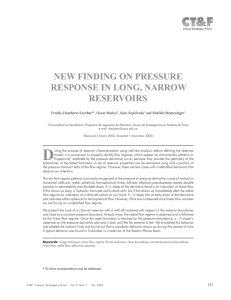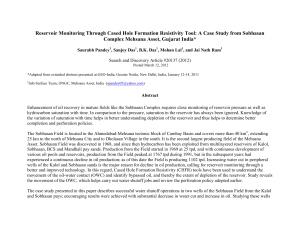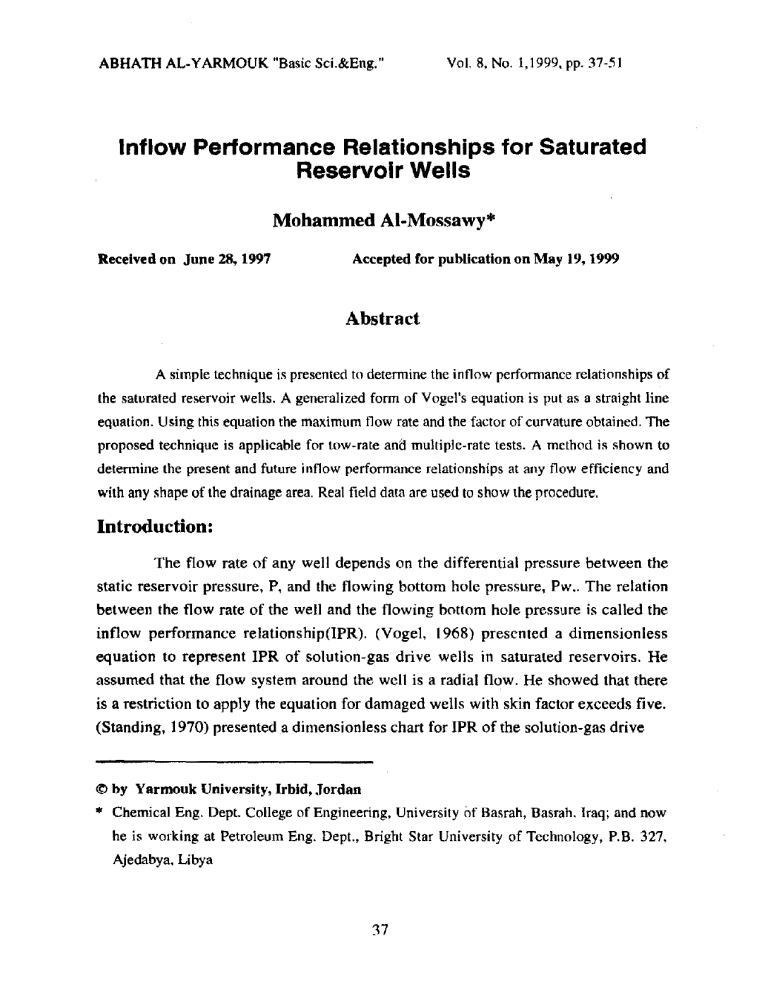
ABHATH AL-Y ARMOUK "Basic Sci.&Eng."
Vol. 8, No. !, 1999, pp. 37-51
lnflow Performance Relationships for Saturated
Reservolr Wells
Mohammed AI-Mossawy*
Received on June 28, 1997
Accepted for publication on May 19, 1999
Abstract
A simple technique is presented to determine the inílow performance relationships of
the salurated reservoir wells. A generalized form of Vogel's equation is put as a straight line
equation. Using this equation the maximum tlow rnte and the factor of curvature obtained. Toe
proposed technique is applicable for tow-rate ano multiple-rate tests. A method is shown to
determine the present and future inílow performance relationships
al
any ílow efficiency and
with any shape of the drainage area. Real field data are used to show the procedure.
Introduction:
The flow rate of any well depends on the differential pressure between the
static reservoir pressure, P, and the flowing bottom holc pressure, Pw .. The relation
between the flow rate of the well and the flowing bottom hole pressure is called the
inflow performance relationship(IPR). (Vogel, 1968) prescnted a dimensionless
equation to represen! IPR of solution-gas drive wells in saturated reservoirs. He
assumed that the flow system around the wcll is a radial flow. He showed that there
is a restriction to apply the equation for damaged wells with skin factor excecds ftve.
(Standing, 1970) presented a dimensionless chart for IPR of the solution-gas drive
© by Yarmouk University, Irbid, Jordan
*
Chemical Eng. Dept. College of Engineering, Universily of Basrah, Basrah. Iraq; and now
he is working at Petroleum Eng. Dept., Bright Star University of Technology, P.B. 327,
Ajedabya, Libya
37
AI-Mossawy
wells with tlow efficiencics differ from one. (Standing, 1971) presented a technique
to prcdict the futurc IPR. (Fetkovich, 1973) presented an equation with two factors
that must be dctcrmined from a multiple-rate test data to represen! the IPR. (Couto
and Golan. 1982) presented a gencralized equation for IPR of solution-gas drive
wells. Their work was based on (Vogel, 1968) and (Standing, 1970 and 1971) work.
111ey showed that the validity of their method is Iimited to small-to-medium capacity
wells. (Richardson and Shaw, I 982) extended the equation of (Vogel, 1968) to new
boundaries. They proposed a generalized from of the IPR equation with a curvature
factor which must be determined from thc test data. They presented a method to
determine this curvature factor from a three-rate test for a well producing from a
highly unsaturated reservoir. (Klins and Clark, 1993) prescnted a technique to predict
future IPR curves. They simulated the inflow pe1formance of21 theoretical sotuion-gas
drive reservoirs. Their tcchnique to predict the IPR curves depended on (Vogel,
I 968) and (Fetkovich, 1973) work. They showed that their technique resulted an
average error with a value 9% for the studied cases. (Wiggns, 1994) presented
generalized IPR equations for three-phase flow in bounded, homogeneous reservoirs.
He used in bis work simulator results for four basic sets of relative permeability and
fluid property data. He proposed to predict the present IPR two equations having the
same form of (Vogel, 1968) equation but with differcnt factors. One ofthese equation
represented TPR of oil phase and the other represented IPR of water phase. Also, he
suggestcd a simple tcchnique to predict the future IPR of each phase. His work are
limited hy the assumptions that (1) the reservoir are initially at the bubble point
prcssure, (2) no initial free gas phase is present, (3) a mobile water phase is present,
( 4) Darcys law for multiphase flow applies, (5) isothermal conditions exist, (6) no
rcactions take place between reservoir fluids and reservoir rock, (7) no gas solubility
exists in the water, (8) gravity effects are negligible and (9) the well bore is fully
pendrating.
The present work proposes a simple method to detennine the curvature factor
from the two-rate and multiple-rate tests data. This method is applicable for saturated
reservoirs with any typc of reservoir drive. Using this method the IPR after changing
the tlow cfficiency, and the future IPR can be predicted.
38
lnflow Performance Rclationships for Saturated Reservoir Wells
Present IPR from Two-Rate Test
(Richardson and Shaw, 1982) prcsented the following generalized IPR equation
Q
Q
= l - VR - (1 - V)R
max
2
.
.......................................................... (1)
Provided that 0>V> 1, which they are the boundaries related to well behavior (two-phase
flow). Qmax and V must be obtained frorn the test data. The present method is
writing Eq. 1 in a fonn of a straight-line equation. The dcrivation of this equation is
shown in appendix A. The final equation of the derivations is:
Q
(1 _ R) = Q max
+ AR
······································································<2)
where A=Qmax(l-V)
Eq. 2 represents a straight line with Qmax as an intercepl and A as a slope. Qrnax
and A can be obtained by solving Eq.2 simultaneously for the two-rate test data. The
final equations from solving Eq.2 sirnultancously are:
A= Rl~R2(1~~1 - ¡~~2) .................................................... (3)
Ql
Qrnax = l-RI -AR!
·····························································......... (4)
V= 1-..,,.....A
__
Q rnax .................................................................................. (5)
Present IPR from Multiple-Rate Test:
For thc multiple-rate testing, using the least squares method A can be calculated
from the slope equation:
11"QR
"'- 1 - R
" 1 -Q R
- ·"
"'-R "'-
A= --------2--······················································<6)
nLR 2 - (LR)
and Qmax can be calculated from_ the intercept cquation:
39
Al-Mossawy
......................................(7)
The curvaturc factor, V, can be calculated from Eq. 5.
IPR after Changing Flow Efficiency:
(Nind, 1964) and (Slider, 1983) defined the tlow efficiency:
E;j
Q
. .................................................................................................... (8)
= --¡¡-;;¡=.1
Q
Applying Eq. 8 into Eq. l yields
E
E;j
Q
--,,-E;--,-1
.
= J( 1 -
2
VR - ( 1 - V) R ) ...................................................... (9)
Qmax
Eq. 9 is a gencralizcd IPR cquation which can be used at any flow efficiency.
Future IPR:
The tlow rate at any tlow efficiency may be obtained from the radial tlow
equation:
QE;i
= 6.~~~;~7~; ~w)
u~;º ). . . . . . . . . . . . . . . . . . . . . . . .
(10)
E;!
Qmax can be obtained lrom Eq. 10 by substituting Pw=0 and s=0. Eq. 10 becomes:
40
Inflow Performance Relationships for Saturated Reservoir Wells
u!;o )................................................................(11)
EQ1 = ~~~~~~fx1;
E=I
Substituting Q max from Eq. 11 into Eq. 9 yields:
akhP
Q E=i -_ 6.283
ln(0.47X)
kro )· (1 _ VR- (1- V)R 2)
J
······················(12)
UoBo
Eq. 12 is a generalized equation to determine the future TPR at any flow efficiency
and any shape of drainage area.
Example 1:
Table I shows the data of well A in South of Iraq. Table 2 shows the
two-rate test data of the same well. It is required to calculate the IPR at the conditions
shown in table 1.
Solution:
l. calculate R 1 and R2
R 1 = Pw
pl
= O. 818
R2 =
p;
2 = 0.744
2. calculate A from Eq. 3.
1
(
QI
Q2
)
A=1IT=""iu\_!-RI - l-R2
A=
1
( 284 . 67 _ 386 .O 1 ) = 760 .4 I m3 /d
0.818- 0.744 1 -0.818
1- 0.744
3. calculate Qmax from Eq. 4
41
AI-Mossawy
_ Q1
_ 284. 67
*
_
3/d
Qmax - I _ Rl -ARI - I _ _
- 760 .41 0.818- 942. l0m
818
0
4. cakulatc V from Eq. 5:
º
A
= 1 - 76 .4l
Qmax
942. 10
V= 1-
= 0.193
5. substitute Qmax and V into Eq. 1 to get present IPR before the stimulation:
2
Q=Qmax( I-VR-(l-V)R )=942.10( l-0. l 93R-0.807R
2
)
(
13)
Fig. 1 shows the present IPR before the stimulation by the presenl method (Eq. 13)
and by Eq. 7 of (Couto and Golan, 1982) shown in appendix B.
E=l
6. calculate Q max from Eq.8
E=j
E=l
Qmax =
_g__
= 942 . l Ü = ,364 64
j
O. 28
·
· m ,u
3 /A
E=l
7. substitute Q max and V into Eq. 9 to get the IPR after the stimulation:
E=j
Q
Q
E=l
2
= Q rnax j( 1 - VR - (1 - V) R )
E=l.3
2
= 3364.64* l.3(1-0.193R- 0.807 R)
............................ (14)
Fig. 2 shows the IPR after the stirnulation by the present method (Eq. 14)
and by Eq. 7 of (Couto and Golan, 1982).
6.283 akh )
(
8. calculate the term ln(0.47X). frorn Eq.11.
E=l
6.283akh)
(
ln(0.47X)
Qmax
=
(P*( u~~º))
3364 .46
= 0.0000615 m3
38273 * 1429. 57
-- -
9. substitute V,
(
6.283 akh )
ln(0.4 7 X) and the future conditions shown in table 1, into Eq.
42
Inflow Performance Relationships far Saturated Reservoir Wells
12 to gel the future IPR.
Q E=j = ( 6.283 akh
ln(0.47X)
)p(
kro ) .(I _ VR- (1 _ V) R3)
UoBo . J
QE=l.3 = 0.0000615. *35500 *833. 33* 1.3(1 - 0.193R - 0.807 R
QE=U
= 2365 .18(1 -
0. !93R - 0.807 R
2
2
) ......................................
)
(15)
Fig. 3 shows the future IPR by the present method (Eq.15) and by Eq. 15 of (Couto
and Golan, 1982) shown in appendix B.
Example2
Table 3 shows a multiple-rate test for well B (Standing 1970). The flow
efficiency and the static reservoir pressure from pressure-buildup analysis are O. 7
and 12755.3 kPa respectively. It is required to calculate the present IPR and IPR
after a stimulation process where the flow efficiency=l .3.
Solution:
1. calculate R 1, R2, R3
Rl = Pwl
P
= 9928
· 45 = O 7784 R2 = 0.6486 RJ = 0.5486
12755 . 3
.
'
' -
2. calculate the terms:
~
QR
"'-, 1 - R
L 1-R
QR = QIRl + Q2R2 + Q3R3
1-Rl
1-R2
1-R3
255 .1 67 m3 /d
LR = Rl + R2 + R3 = 1.9756
~
Q
Ql
Q2
Q3
"'-,1-R = 1-Rl + 1-R2 + 1-R3
43
387 •447 m3/d
Al-Mossawy
""'
.L.,R 2
= Rl 2 + R2 2 + R3 2 = 1.3276
3. calculate A from eq.6:
A= _n_L_1_~_RR_-_L_R..,.L_\_~_R_ = 3* 255. t 67 - l. 9756 * 387 . 447 = O.
2
"LR2-(LR)
7607
rn3/d
3*1.3276 -(1.9756)
4. calculate Qrnax from Eq.7
LR L1 ~ R - LRL1~RR
nLR2-(LR)
2
Qmax =
Qmax
2
= l.3276*387.447-1.9756*255.167
=l 2S.648m3/d
3* 1.3276 - (l. 9756 /
5. calculate V from Eq. 5
V= 1-
A
- 1 - o. 7607 - O 994
128.648 - .
Qma¡¡. -
6. substitute Qmax and V into Eq. 1 to get the present IPR
2
Q=Qmax (l-VR-(l-V)R )=128.648(1-0.994R-0.006R2)
......................
(16)
Fig. 4 shows the present IPR at flow efficiency = 0.7 by the present method
(Eq.16) and by Eq. 7 of(Couto and Golan, 1982).
7. use the same procedure used in example I to gel the IPR after the stimulation
process at flow efficiency = 1.3, which is represented by the equation:
2
) ........................................................(
QF=U=238.9 l 8( l -0.994R-0.006R
44
17)
Inflow Performance Relationships for Saturated Reservoir Wells
Fig. 5 shows the IPR after the stimulation by the present method (Eq. 17) and by Eq.
7 of (Couto and Golan, 1982)
Discussion:
Type of the reservoir drive affects the curvature of the IPR. Methods of
(Vogel, 1968), (Standing 1970 and 1971), (Couto and Golan, 1982), (Klins and
Clark, 1993) and (Willgns, 1994) are made for solution-gas drive reservoirs. These
methods are not applicable for conibination (water and/or gravity and solution gas)
drive reservoirs. Determining the curvature factor from the test data may be the
favorable method for any type of the reservoir drive and for any well production
capacity.
Fig. l shows the test-time IPR for well A which is a large-capacity well. Fig.
4 shows the test-time IPR for well B which is a small-capacity well. It is observed
that the deviation between the present method and (Couto and Golan, 1982) method
is increasing with increase of the flow rate. (Couto and Golan, 1982) showed that
their method is limited to small-to medium capacity wells. They showed that significant
deviations are observed at production rates of 477 cu.m/d and higher. Tables 4 and 5
show deviations between the measured and calculated flow rates for wells A and B
respectively.
The present method does not nced the value of the flow efficiency to determine
the present IPR. Thus the determined IPR is unaffacted by the mistakable pressurebuildup analysis. The flow cfficiency value is required to predict the IPR after the
stimulation process. Figures 2 and 5 show IPRs for wells A and B respectively, after
stimulation operations. It is observed that (Couto and Golan, 1982) method gets
reverse IPRs al the flow efficiency values more than one.
Assuming that there is no change in the reservoir drive mechanism, the
future IPR can be predicted. Figure 3 shows the future IPR for wcll A. The curvature
factor indicates type of the reservoir drive mechanism when the tested wel\ flow
efficiency equals one. The zero curvature factor indicates compressible flow and unit
curvature factor indicates incompressible flow through the reservoir medium.
45
AJ-Mossawy
Conclusions:
1.
It is proposed a simple method to determine the curvature factor of the IPR from
thc two-ratc and multiplc-rate tests.
2.
Thc proposed method can be used for any reservoir drive mechanism and any
capacity of well production.
3.
The flow efficiency value is not required for determining the IPR at the test
time.
4.
The future IPR can be predicted for certain future static reservoir pressures,
drainage arca shape and fluid properties.
5.
The determined curvature factor indicates the reservoir drive mechanism when
the flow efficiency of the tested well equals one.
Nomenclature:
A=Qmax(l-V),m'/d
2
a=unit conversion factor; for metric units (m, Pa, Pa.s, m , m'ld) a=86400; for any
consistent set of units a= 1.
3
Bo=oil formation volume factor, res m /stock-tank m
3
E=tlow efficiency
h=thickness, m
j=a.real positive number indicates the value oftlow efficiency
k=absolute permeability, m'
kro=relative oil permeability, fraction
n=number of flow rates
P=static reservoir pressure, Pa
Pw=flowing bottom hole pressure, Pa
3
Q=surface-rneasured oil tlow rate, m /d
46
Inflow Performance Relationships for Saturated Reservoir Wells
Qmax=maximum oil tlow rate al surface condition, m·'/d
R=Pw/P
s=dimensionlcss skin factor
Uo=oil viscosity, Pa.s
X= drainage area shape factor (Odeh, 1978).
;,_ · I' .;,i..tl J~J r,...rr ~l.af ~~
\?.,..,.j11 (,)'J:,IJJ!
~
· IS..ll ._,.
· ~
.::...:.JI WIJl
.:,l:iy.,,. ..,~J....-....,.,
.1-¡
r- l ~ I f"• .w . ~
• I ._,.
• I J.¡¡JI J L.'i
. ...,..
•
•
• . • """"1 C..r-
r-t-,.YI .:,~I J..._. -':!....:i,.:; (!JL..11 ol.> ,.1.........,4., - ~ J.... <!JI....~ 4.-..iuJ JS_,i (!JLA! :t.Lc ~
~J..A.11.:,lj <+;,-1.J¡'fl .:.L.....~I ~ l I i: :b; :.,~ ..,...,.:a.11 U._..,J.JI ol.A .Jj.wll ~IJl ü)I.,,. """'"'J.,.Lc_,
.:.L...,_I... r-1,s.;.:...½ .illj_, '-':!_.,...;;ll <...W ~ \,SYJ _,:.,JI.:,~.,.;,,¡.~~ \,S)' <:I :i1 1t, ~l:¡j'f l .:.t-.,....ill,
~~
References:
Couto. L.E. ami Golan, M.: "General Jnflow Performance Relatiunship for Solution-Gas
Reservoir Wells", J. Pet. Tech. (Feh. 1982) 285-288.
Fetkovich, M.K.: "The Isochronal Testing uf Oil Wells", paper SPE 4529 presented
al the 1973 SPE Annual Meeting, Las Vegas, Sept. 30- Oct. 3.
Klins. M.A. and Clark III, J.W.: "An Improvcd Method to Predict Future IPR Curves",
SPE Reservoir Engineering (Nov. 1993) 24~-248.
Nind, T.E.W., Principies of Oil Well Productiun (Ncw York: McGraw-Hill, 1964),
P. 39.
47
Al-Mossawy
Odeh, A.S.: "Pseudosteady-State Flow·Equation and Productivity Index for a Well
with Noncircular Drainagc Area", J.Pet Tech. (Nov. 1978) 1630-1632.
Richardson, J.M. and Shaw, A.H.: "Two-rate IPR testing-a practica! production too!",
J. Canadian Pet. (March-April 1982) 57-60.
Slider, H.C., Worldwide Practica! Petroleum Reservoir Engineering Methods (Tulsa,
Oklahoma: Penn Well Publishing Com., 1983) P. 43.
Standing M.B.: "Inflow Performance Relationshi_ps for Damagcd Wells Producing
by Solution-Gas Orive", J. Pct. Tech_ (Nov. 1970) 1399-1400. ·
Standing, M.B.: "Concerning the Calculation of Inflow Performance of Wells
Producing from Solution-Gas Orive Reservoirs", J. Pet. tech. (Sept. 1971)
1141-1142.
Vogel, J.V.: "lnflow Performance Relationships for solution-Gas Drive Wells", J.
Pet. Tech. (Jan. 1968) 83-92; Trans,., AIME, 243.
Wiggins, M.L.: "Gcneralized Inflow Performance Relationships for Three-phase Flow",
SPE Reservoir Engineering (Aug. 1994) 181-182.
Appendix A: Derivation of Eq. 2
Eq. 1 can be written in the following form
Q
2
Q max = (l - R ) - VR(l - R)
........................................................ (lA)
Simplifying eq. IA yields:
QQ
= (l
-R)(l + R(I -V))
max
........................................................ (2A)
Multiplying Eq. 2A by the term [Qmax/(1-R)] yields
Q
1-
R=Qmax+Qmax(I-V)R
48
.................................................... (3A)
Intlow Performance Relationships for Saturatcd Rcservoir Wells
Toen
1
Q
_ R
=Q rnax + AR
......................................... ,.............................. (2)
Appendix B:
Eq. 7 of (Couto and Golan, 1982) is
E=j
_Q_E=--=j(l-R)(l.8
1
-0.8,i(l -R))
Qrnax
and Eq. 15 of (Couto and Golan, 1982) is
Q
E =i
akh
(
=3.49 ln(0.4X)
p
kro ) .
.
BoUo J(l - R)(l.8- 0.8J(l - R))
Table 1-Data of Well A
Propcrty
P,kPa
E
Kro
l
UoBo 'Pa.s
Present-Tirne Condition
Beforc Stirnulation
After Stirnulation
Future-Tirne
Condition
38273
38273
35500
0.28
1.3
1.3
1429.57
1429.57
833.33
Table 2-Two Rate Test Data for Well A
Q(rn Id)
Pw(kPa)
284.67
31309
386.01
28475
49
AI-Mossawy
Table 3-Multible-Rate Test Data for Well B
Q(m
3
Pw(kPa)
/d)
9928.45
8273.71
6998.18
27.35
50.08
54.85
Table 4-Flow Rate Deviation for Well A
Pw(kPa)
1
Q(m\d)
Q(m /d)
·ocviation %=
Q( cal . ) - Q ( measu .)
Q(measu .)
x.100
(calculated)
(measured)
Present
Couto
Present
Couto
method
method
method
method
31309
284.65
284.65
280.85
-0.0074
-1.34
28475
386.01
385.98
391.33
-0.0078
1.38
0.0076
1.36
Average Absolute Deviation %
Table 5-Flow Rate Deviation for Well B
Q(m'/d)
Pw(kPa)
Deviation %= Q(cal .) -Q(measu .) x!OO
Q(measu .)
(measured)
9928.45
8273.71
6998.18
27.35
50.08
54.85
(calcu_lated)
Present
method
28.64
45.38
58.26
Couto
method
29.92
45.39
56.27
Average Absolute De\'.;iation %
50
Present
method
4.72
-9.38
6.22
Couto
method
9.40
-9.37
2.57
6.77
7.12
Inflow Performance Rclationships for Saturatcd Rescrvoir Wells
"'
'
" ~
,,
~·
•.
·,.
COlJTO MET!!OD
'<
:H "
....)
PRESENT METHOLJ
covro r.1E·11101J
'•·-::
/,
.,,.,,
PRESENT METIIQD
'-'
'·' ,,
' \''
}O
'el
!!: ,,
\
'º
'
\\'',,,_
\\
\
5
'o
ir:r·,
l(){J
(-r\~
lle)()
\,~,,
,'
~~~~~~~~·---,---,----,~--.----,---.-,- r Í r ~ -,,~.,.......
t 100
l fOCI
\'.LOO
1~00
'Y)':,O
1~-,1.1 J1c>o'.,
2ll"-c
1
.!,fu:\_:,
•o•>ó t,or;
l
FLOW HATE(m Id)
FLOW RATE(m /d'!
Fig.2-iPR for 11dl A artn :he ~liÍ:n:l:ition
;i! ílow cfliciew.:.--y•= 1 3
Fig.1-Prcscnl IPR fur wcll A :11 !low cllic1cncy' 0.28
"
PRESENT MET!IOD
couro
\
., .
Pl'ESHIT MET/10D
COUTO METl !UlJ
"
MFrnoo
"
,e
f,:
iií
'
~
V,
V,
"~
'\
.
o
;C<,
~ ,.
¡.
'.
1- ~ . -, --, --.--,--,.....--,--.-,-....---.~1J t-'.>
lf,OO
J:Ji•J
:Hoi'J
1
FLOW RATE(m /d)
fLOW ltATE(ni /d)
fig 1 Fu!uit: JP!l for wcll A .11 now cmcicni.:_1·~l.J
Fig.4-Prcscn¡ IPn for wcll
Í3
.11 flo11 cffícic;1cy-·U.7
F'RESF.NT METHOD
COlHO METH()D
O O •~r
'0
•~o
1
1'1 0
\o}:)
160
l~ó · 1~0
I~~
:;(X1
,Ju~;.,,
J
.
FLOW RA TE(m id)
Fig.5-IPR for wcll O aflcr thc stimululion :it llow cflidcm.yl.J
10
51
